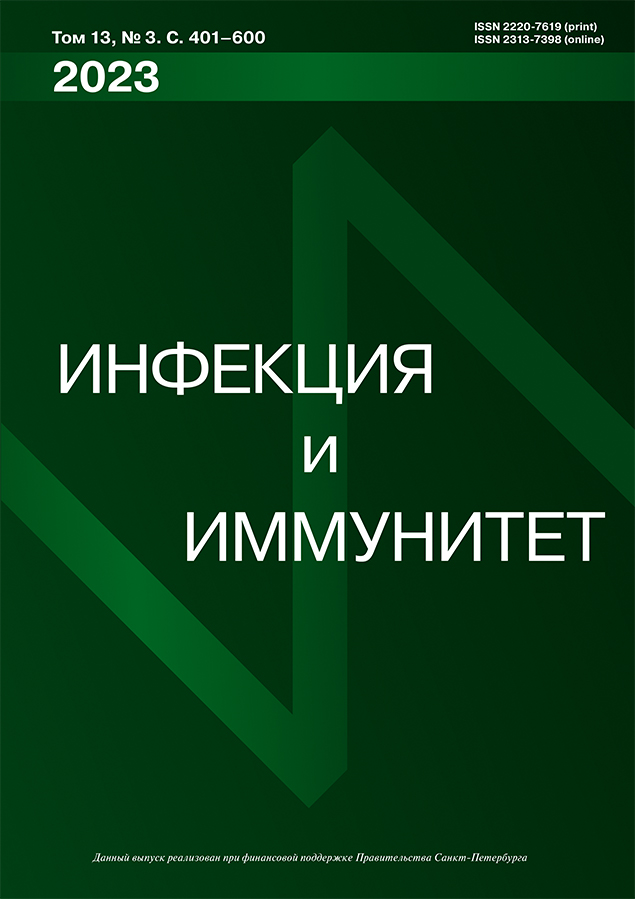TLR3 and TLR7 prognostic role in early pediatric rotavirus infection
- Authors: Gorbunov S.G.1, Mazankova L.N.1, Os'kin A.N.1
-
Affiliations:
- Russian Medical Academy of Continuig Professional Education of the Ministry of Healthcare of the Russian Federation
- Issue: Vol 13, No 3 (2023)
- Pages: 579-585
- Section: SHORT COMMUNICATIONS
- URL: https://bakhtiniada.ru/2220-7619/article/view/133208
- DOI: https://doi.org/10.15789/2220-7619-TAT-2045
- ID: 133208
Cite item
Full Text
Abstract
Introduction. Rotavirus infection is an urgent problem for pediatric infectology. The disease does not always proceed smoothly, it is assumed that TLR3 and TLR7 play an important role in its prognosis. The initial number of cells expressing such receptors in early children can probably be considered a predictor of unfavorable course and outcomes of rotavirus infection.
Materials and methods. Infants with rotavirus infection were divided into groups depending on the initial count of TLR3- and TLR7-expressing immunocompetent cells. All patients were examined using general clinical methods. Rotavirus infection was diagnosed by molecular genetic (RNA detected by PCR) and immunochromatographic (determination of antigen) method. Parameters of cellular immunity were assessed by flow cytometry. Statistical data processing was carried out using the Statistica 8.0 program for independent samples using the nonparametric Mann–Whitney criterion and the Pearson criterion c2.
Results. It was found that in patients with an initially small vs. high count of TLR3-expressing cells, the symptoms of exicosis were observed significantly longer, which determined a significantly longer infusion rehydration therapy. In patients with an initially small count of TLR7-expressing cells, no significant differences were observed during disease course. However, only this group similar to infants with a small count of TLR3-expressing cells were treated with antibiotics due to concomitant bacterial infections. Only convalescents with small count of simultaneously TLR3- and TLR7-expressing cells had repeated episodes of ARI and allergic diseases in catamnesis, whereas infants with extremely low count of TLR3-expressing cells developed additionally an unfavorable outcome such as reactive pancreatopathy.
Conclusion. The initially low count of TLR3- and TLR7-expressing immunocompetent cells leads to a more severe course of rotavirus infection in infants requiring adjusted therapy by introducing antibacterial drugs and in some cases also contributes to arising adverse outcomes and consequences in 6–12 month catamnesis.
Full Text
##article.viewOnOriginalSite##About the authors
Sergey G. Gorbunov
Russian Medical Academy of Continuig Professional Education of the Ministry of Healthcare of the Russian Federation
Email: gsgsg70@mail.ru
ORCID iD: 0000-0001-6335-0487
DSc (Medicine) Head of the Department of Children's Infectious Diseases, Professor of the Department of Children's Infectious Diseases
Russian Federation, 123995, Moscow, Barrikadnaya str.,2/1Ludmila N. Mazankova
Russian Medical Academy of Continuig Professional Education of the Ministry of Healthcare of the Russian Federation
Email: mazankova@list.ru
DSc (Medicine), Professor, Head of the Department of Children’s Infectious Diseases
Russian Federation, 123995, Moscow, Barrikadnaya str.,2/1Alexandr N. Os'kin
Russian Medical Academy of Continuig Professional Education of the Ministry of Healthcare of the Russian Federation
Author for correspondence.
Email: o_alksandr@mail.ru
PhD Student, Department of Children’s Infectious Diseases
Russian Federation, 123995, Moscow, Barrikadnaya str.,2/1References
- О состоянии санитарно-эпидемиологического благополучия населения в Российской Федерации в 2021 году: Государственный доклад. М.: Федеральная служба по надзору в сфере защиты прав потребителей и благополучия человека,2022. 340 с. [On the state of sanitary and epidemiological welfare of the population in the Russian Federation in 2021: State Report. Moscow: Federal Service for Supervision of Consumer Rights Protection and Human Well-Being,2022. 340 p. (In Russ.)]
- Amimo J.O., Raev S.A., Chepngeno J., Mainga A.O., Guo Y., Saif L., Vlasova A.N. Rotavirus interactions with host intestinal epithelial cells. Front. Immunol.,2021, no. 12: 793841. doi: 10.3389/fimmu.2021.793841
- Günaydın G., Nordgren J., Svensson L., Hammarström L. Mutations in toll-like receptor 3 are associated with elevated levels of rotavirus-specific IgG antibodies in IgA-deficient but not IgA-sufficient individuals. Clin. Vaccine Immunol.,2014, vol. 21, no. 3, pp. 298–301. doi: 10.1128/CVI.00666-13
- Miya T.V., Groome M.J., de Assis Rosa D. TLR genetic variation is associated with rotavirus-specific IgA seroconversion in South African black infants after two doses of Rotarix vaccine. Vaccine,2021, vol. 39, no. 48, pp. 7028–7035. doi: 10.1016/ j.vaccine.2021.10.051
- Oh H.-M., Lee S.W., Park M.H., Kim M.H., Ryu Y.B., Kim M.S., Kim H.-H., Park K.H., Lee W.S., Park S.-J., Rho M.-C. Norkurarinol inhibits toll-like receptor 3 (TLR3)-mediated pro-inflammatory signaling pathway and rotavirus replication. J. Pharmacol. Sci.,2012, vol. 118, no. 2, pp. 161–170. doi: 10.1254/jphs.11077fp
- Patel M.C., Shirey K.A., Pletneva L.M., Boukhvalova M.S., Garzino-Demo A., Vogel S.N., Blanco J.C. Novel drugs targeting toll-like receptors for antiviral therapy. Future Virology,2014, vol. 9, no. 9, pp. 811–829. doi: 10.2217/fvl.14.70
- Pott J., Stockinger S., Torow N., Smoczek A., Lindner C., McInerney G., Bäckhed F., Baumann U., Pabst O., Bleich A., Hornef M.W. Age-dependent TLR3 expression of the intestinal epithelium contributes to rotavirus susceptibility. PLoS Pathog.,2012, vol. 8, no. 5: e1002670. doi: 10.1371/journal.ppat.1002670
- Sen A., Ding S., Greenberg H.B. The role of innate immunity in regulating rotavirus replication, pathogenesis, and host range restriction and the implications for live rotaviral vaccine development. Mucosal Vaccines,2020, no. 40, pp. 683–697. doi: 10.1016/b978-0-12-811924-2.00041.9.
Supplementary files









